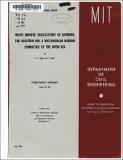| dc.contributor.author | Ippen, A. T. | en_US |
| dc.contributor.author | Goda, Y. | en_US |
| dc.date.accessioned | 2022-06-13T13:07:25Z | |
| dc.date.available | 2022-06-13T13:07:25Z | |
| dc.date.issued | 1963-07 | |
| dc.identifier | 59 | |
| dc.identifier.uri | https://hdl.handle.net/1721.1/142984 | |
| dc.description | Prepared under Office of Naval Research, U.S. Department of the Navy, contract no. Nonr-1841(69) NR-062-228 | en_US |
| dc.description.abstract | The determination of an amplification factor for a given harbor and a given wave period is an important problem concerning long period oscillations in harbors. The present study presents a means of computing the response of a rectangular harbor to the excitation by incident waves. With the aid of a digital computer, the complete response curve can be computed for any rectangular harbor. The results of experiments on model harbors have confirmed the validity of the computation. Experimental response curves, however, do not show the marked increase of the amplification factor at resonance with a narrowing of the harbor entrance, because of energy dissipation in a model harbor. The analysis of the response factor for waves with a continuous power spectrum also suggests that a narrowing of the entrance will lead to a reduction in the amplitude of long period oscillations in actual harbors, because of increasing sharpness of the response curves and the presence of energy dissipation mechanisms in harbors. Hence, the problem of the harbor paradox presented by Miles and Munk does not exist in actual harbors. In addition to the above resonant characteristics, a study was conducted on the minimum effectiveness of wave absorbers and filters to simulate the open-sea conditions in a wave basin of finite dimensions. A reflection coefficient less than 0.2 is recommended for wave absorbers and filters. The importance of the basin size is also discussed. | en_US |
| dc.publisher | Cambridge, Mass. : Hydrodynamics Laboratory, Dept. of Civil Engineering, Massachusetts Institute of Technology | |
| dc.relation.ispartofseries | R (Massachusetts Institute of Technology. Department of Civil Engineering) ; 63-36. | |
| dc.relation.ispartofseries | Report (Massachusetts Institute of Technology. Hydrodynamics Laboratory) ; no. 59. | |
| dc.title | Wave Induced Oscillations in Harbors: The Solution for a Rectangular Harbor Connected to the Open-sea | en_US |
| dc.identifier.oclc | 4280662 | |
| dc.identifier.aleph | 247798 | |
